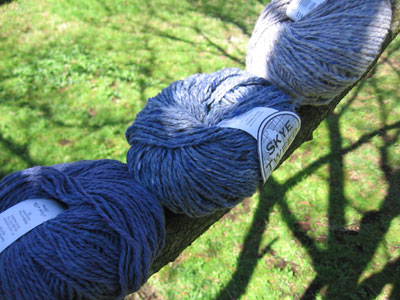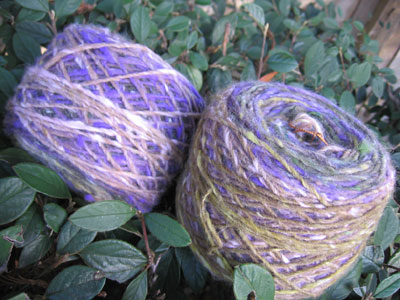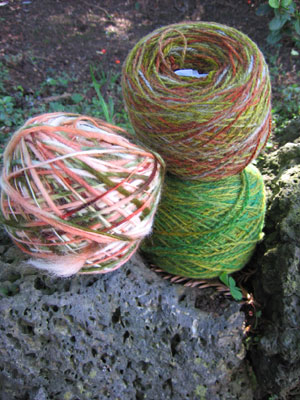Today, I’ve been knitting cotton wash rags, a la Mason-Dixon Knitting. Joann had Sugar ‘n Cream cotton yarn on sale for $1.50 a ball, and I’ve never actually knit these before—so it seemed almost like a sign or something. I find the wash rags inordinately pleasing. I’m using bright colors and every few rows I hold my work up so Melissa can admire it. Her comment: “There must be somethig really specal about those. These days, it usually takes more than a knitted square to get you excited like this.”
Yesterday, Melissa and I joined my mom to go to the musical at the high school I attended. While we were at my mom’s house, we shot pictures of my various yarn buys from Stitches West. So, here are the yarns I found most tantalizing, with my dreams about what they may become someday.

Skye Tweed by Classic Elite Yarns, 100% wool, 110 yards per ball, US 7 or 8 needles.
This yarn has that nice, sort of crunchy feel to it that some wools have, but doesn’t feel scratchy. Last fall I knit up some ocean-inspired hats, using knit stitches for the first pattern set, purls for the next, etc. Now I’d like to try working up the same pattern, using color changes instead of stitch changes to make the pattern more striking. I’m hoping Skye Tweed will be just the ticket.

Mmmmmmmmm…Malabrigo. They’re all 100% wool. In the back we have worsted weight (216 yards per skein, US 7-9 needles): 3 balls of Melilla and 5 balls of Col China. In the front we have a skein of lace-weight in Sealing Wax (410 yards per skein).
I love this yarn and its cotton-ball softness. I have a rectangular shawl pattern picked out for the lace weight. I’m not at all sure yet what I’ll be doing with the worsted weight, but I can tell you whatever I knit will be for me. Me. Me, me, me, me, me.

Silver Thaw by Noro, 50% wool, 25% angora, 25% nylon, 220 meters per skein, US 8-10 needles.
I knit a hat for Melissa in December out of a different colorway of this yarn and enjoyed working with it. The angora takes the edge off the roughness that that’s typical of Noro, making it more comfortable to wear against the skin. This colorway reminds me of fields of lavender or sage with its grey-greens (which didn’t show well in the photo) and purples. Again, I don’t know what I’ll be knitting with this, but the knitting voices in my head told me “Buy it! Buy two!”

On the left: Magallanes by Araucania Yarns, 100% wool, 242 yards per skein, US 6-8 needles. On the right: Caravan by Just Our Yarn, 65% wool, 35% camel down, 300 yards per skein, US 3 needles.
I felt compelled to get the Magallanes because of the color, which seemed simultaneously hideous and alluring: a melange of forest green, burnt orange, peach, and cream. These colors shouldn’t match, they don’t match, but they do—kind of like Peter Cottontail attending Octoberfest. This yarn will no doubt become a hat at some point, but I don’t want to reknit a pattern I’ve already written. I’m waiting for the right new idea to come along.
The moment I saw the Cravan I thought “stranded color-work.” I want to work with these separately, pairing each with a rich deep, brown or a warm gold. The skeins are big enough that if I make hats I can knit each pattern twice, once with the Caravan as the main color, then again with it as the contrast color.

Cashsoft by Rowan, 50% merino, 40% microfibre, 10% cashmere, 142 yards per ball, US 6 six needles.
With these beauties I’m again thinking stranded color-work, but I also expect they’ll show texture nicely, so I may just opt for a nice complicated scarf with cables or bobbles or both. (The upper yarn is actually a yummy butter yellow, not the off-white it appears in the picture.)
If any of you have worked with these yarns before and have advice or project ideas, I would love to hear them. I don’t expect I’ll start knitting with any of them for a few weeks—I want time to think about the possibilities first. Meanwhile, I’ve got cotton wash rags to occupy my fingers.





